2007 Hyundai Santa Fe air
[x] Cancel search: airPage 55 of 355
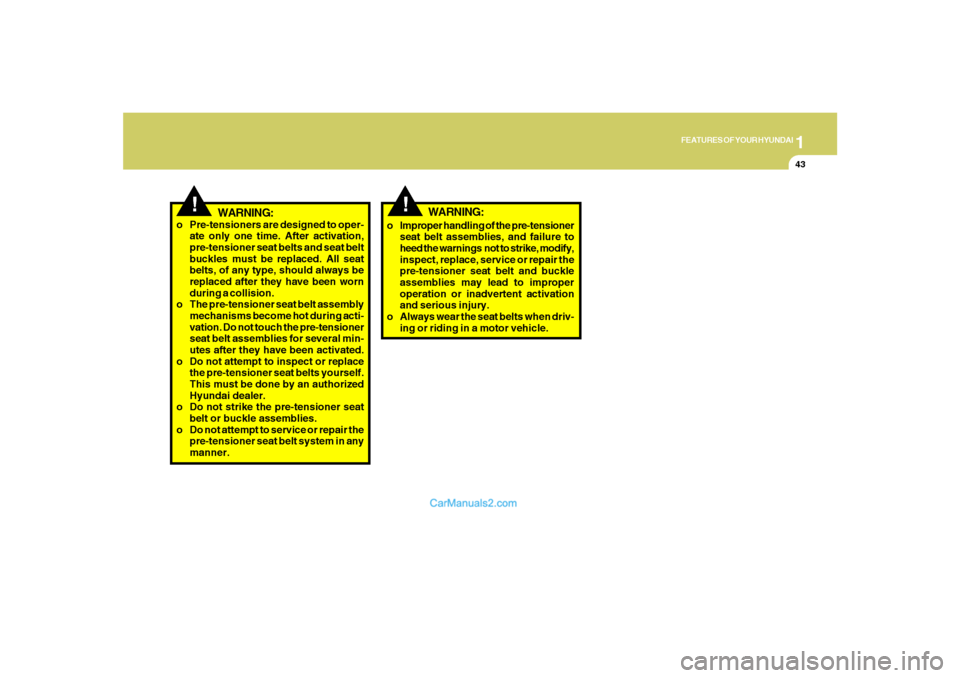
1
FEATURES OF YOUR HYUNDAI
43
!
WARNING:
o Pre-tensioners are designed to oper-
ate only one time. After activation,
pre-tensioner seat belts and seat belt
buckles must be replaced. All seat
belts, of any type, should always be
replaced after they have been worn
during a collision.
o The pre-tensioner seat belt assembly
mechanisms become hot during acti-
vation. Do not touch the pre-tensioner
seat belt assemblies for several min-
utes after they have been activated.
o Do not attempt to inspect or replace
the pre-tensioner seat belts yourself.
This must be done by an authorized
Hyundai dealer.
o Do not strike the pre-tensioner seat
belt or buckle assemblies.
o Do not attempt to service or repair the
pre-tensioner seat belt system in any
manner.
!
o Improper handling of the pre-tensioner
seat belt assemblies, and failure to
heed the warnings not to strike, modify,
inspect, replace, service or repair the
pre-tensioner seat belt and buckle
assemblies may lead to improper
operation or inadvertent activation
and serious injury.
o Always wear the seat belts when driv-
ing or riding in a motor vehicle.
WARNING:
Page 56 of 355
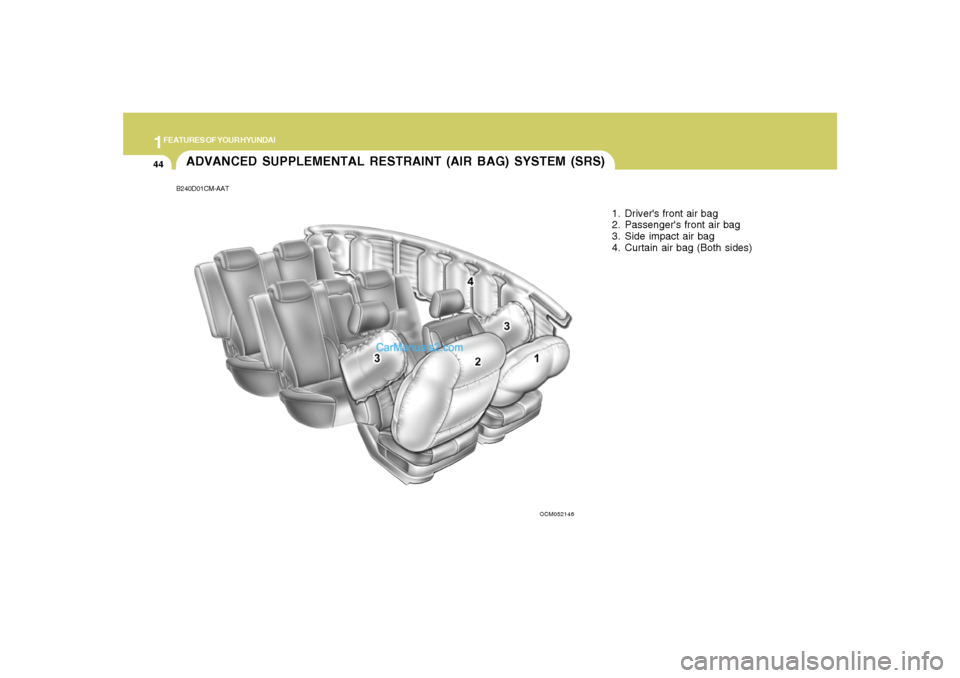
1FEATURES OF YOUR HYUNDAI44
B240D01CM-AATADVANCED SUPPLEMENTAL RESTRAINT (AIR BAG) SYSTEM (SRS)
1. Driver's front air bag
2. Passenger's front air bag
3. Side impact air bag
4. Curtain air bag (Both sides)
OCM052146
Page 57 of 355

1
FEATURES OF YOUR HYUNDAI
45
The SRS uses a collection of sensors to
gather information about the driver's and
front passenger's seat position, the driver's
and front passenger's seat belt usage and
impact severity.
The driver's seat position sensors, which
are installed on the seat track, determine
if the seats are fore or aft of a reference
position. Similarly, the seat belt usage
sensors determine if the driver and front
passenger's seat belts are fastened. These
sensors provide the ability to control the
SRS deployment based on how close the
driver's seat is to the steering wheel,
whether or not the seat belts are fastened,
and how severe the impact is.
The advanced SRS offers the ability to
control the air bag inflation with two levels.
A first stage level is provided for moderate-
severity impacts. A second stage level is
provided for more severe impacts.According to the impact severity, driver's
seating position, the SRSCM(SRS Con-
trol Module) controls the air bag inflation.
Failure to properly wear seat belts can
increase the risk or severity of injury in an
accident.
Additionally, your Hyundai is equipped
with an occupant classification system in
the front passenger's seat. The occupant
classification system detects the presence
of a passenger in the front passenger's
seat and will turn off the front passenger's
air bag under certain conditions. For more
detail, see "Occupant Classification Sys-
tem" later in this section.
DRIVER'S AND PASSENGER'S FRONT AIR BAGB240A01CM-AATYour Hyundai is equipped with an ad-
vanced Supplemental Restraint (Air bag)
System. The indications of the system's
presence are the letters "SRS AIR BAG"
embossed on the air bag pad cover in the
steering wheel and the passenger's side
front panel pad above the glove box.
The Hyundai SRS consists of air bags
installed under the pad covers in the cen-
ter of the steering wheel and the
passenger's side front panel above the
glove box. The purpose of the SRS is to
provide the vehicle's driver and/or the front
passenger with additional protection than
that offered by the seat belt system alone,
in case of a frontal impact of sufficient
severity.
OCM051008L
Driver's Air bag
Page 58 of 355

1FEATURES OF YOUR HYUNDAI46
!
CAUTION:
If the seat position sensor is not working
properly, the SRS air bag warning light
on the instrument panel will illumi-
nate even if there is no malfunction of the
SRS air bag system, because the SRS
air bag warning light is connected with
the seat position sensor. If the SRS air
bag warning light does not illuminate
when the ignition key is turned to the
"ON" position, if it remains illuminated
after coming on for approximately 6 sec-
onds, or if it illuminates while the vehicle
is being driven, have an authorized
Hyundai dealer inspect the seat position
sensor and the advanced SRS air bag
system as soon as possible.
!
WARNING:
o Modification to the seat structure can
adversely affect the seat position
sensor and cause the air bag to de-
ploy at a different level than should be
provided.
o Do not place any objects underneath
the front seats which could damage
the seat position sensor or interfere
with the occupant classification sys-
tem.
o Do not place any objects that may
cause magnetic fields near the front
seats. These may cause a malfunc-
tion of the seat position sensor.
NOTE:o Be sure to read information about the
SRS on the labels provided on the
backside of the sun visor and in the
glove box.
o Advanced air bags are combined with
pre-tensioner seat belts to help pro-
vide enhanced occupant protection
in frontal crashes. Front air bags are
not intended to deploy in light colli-
sions in which protection can be pro-
vided by the pre-tensioner seat belt.
o If you are considering modification of
your vehicle due to a disability, please
contact the Hyundai Customer As-
sistance Center at 1-800-633-5151.
AIR
BAG
Page 59 of 355
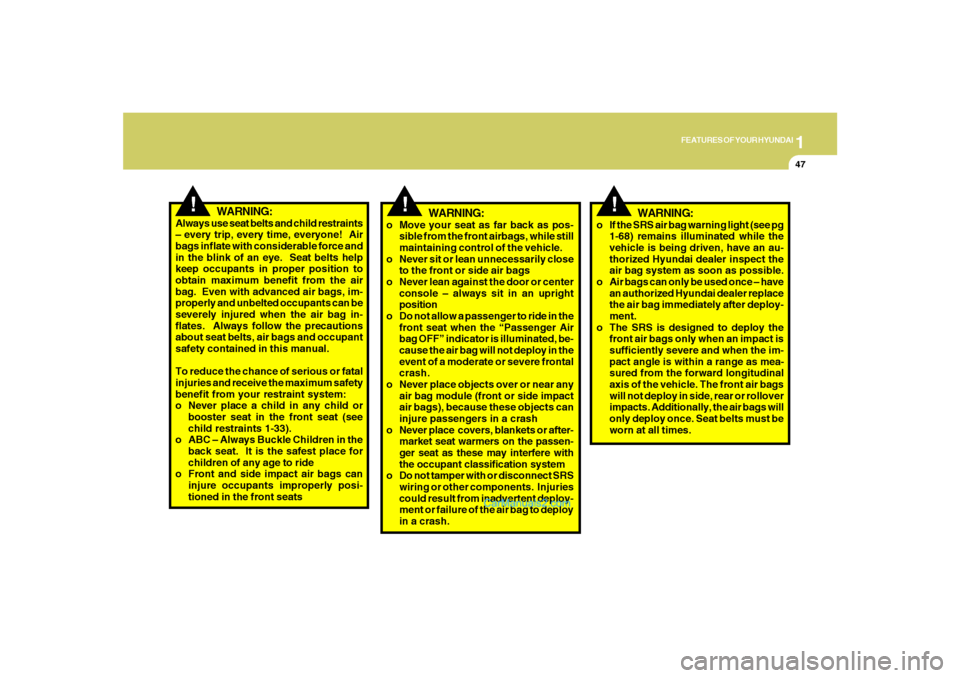
1
FEATURES OF YOUR HYUNDAI
47
!
!
WARNING:
!
WARNING:
Always use seat belts and child restraints
– every trip, every time, everyone! Air
bags inflate with considerable force and
in the blink of an eye. Seat belts help
keep occupants in proper position to
obtain maximum benefit from the air
bag. Even with advanced air bags, im-
properly and unbelted occupants can be
severely injured when the air bag in-
flates. Always follow the precautions
about seat belts, air bags and occupant
safety contained in this manual.
To reduce the chance of serious or fatal
injuries and receive the maximum safety
benefit from your restraint system:
o Never place a child in any child or
booster seat in the front seat (see
child restraints 1-33).
o ABC – Always Buckle Children in the
back seat. It is the safest place for
children of any age to ride
o Front and side impact air bags can
injure occupants improperly posi-
tioned in the front seatso Move your seat as far back as pos-
sible from the front airbags, while still
maintaining control of the vehicle.
o Never sit or lean unnecessarily close
to the front or side air bags
o Never lean against the door or center
console – always sit in an upright
position
o Do not allow a passenger to ride in the
front seat when the “Passenger Air
bag OFF” indicator is illuminated, be-
cause the air bag will not deploy in the
event of a moderate or severe frontal
crash.
o Never place objects over or near any
air bag module (front or side impact
air bags), because these objects can
injure passengers in a crash
o Never place covers, blankets or after-
market seat warmers on the passen-
ger seat as these may interfere with
the occupant classification system
o Do not tamper with or disconnect SRS
wiring or other components. Injuries
could result from inadvertent deploy-
ment or failure of the air bag to deploy
in a crash.o If the SRS air bag warning light (see pg
1-68) remains illuminated while the
vehicle is being driven, have an au-
thorized Hyundai dealer inspect the
air bag system as soon as possible.
o Air bags can only be used once – have
an authorized Hyundai dealer replace
the air bag immediately after deploy-
ment.
o The SRS is designed to deploy the
front air bags only when an impact is
sufficiently severe and when the im-
pact angle is within a range as mea-
sured from the forward longitudinal
axis of the vehicle. The front air bags
will not deploy in side, rear or rollover
impacts. Additionally, the air bags will
only deploy once. Seat belts must be
worn at all times.
WARNING:
Page 60 of 355
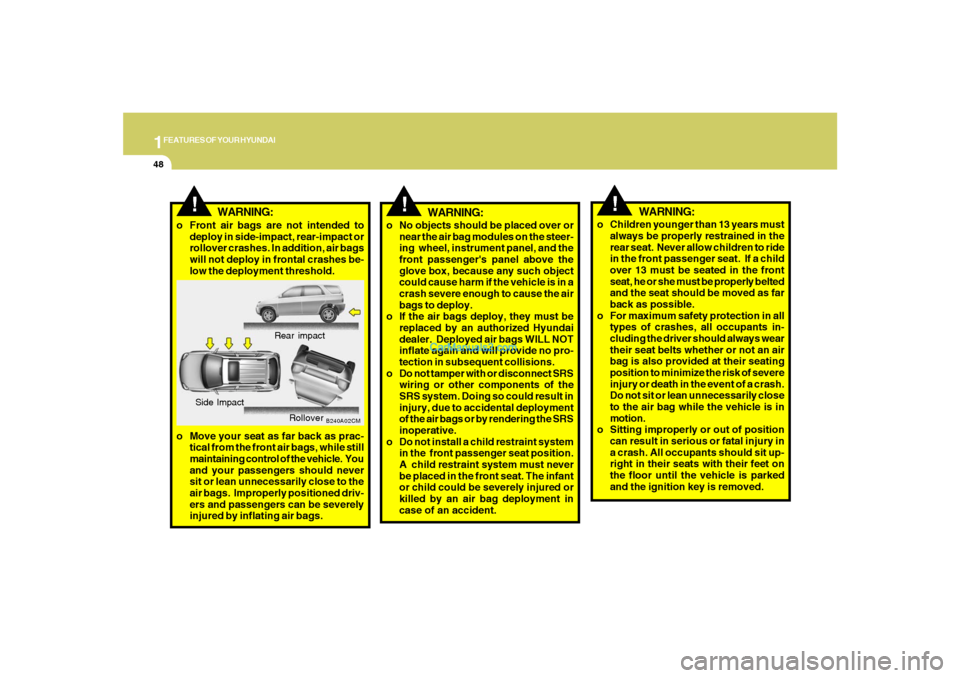
1FEATURES OF YOUR HYUNDAI48
!
WARNING:
o No objects should be placed over or
near the air bag modules on the steer-
ing wheel, instrument panel, and the
front passenger's panel above the
glove box, because any such object
could cause harm if the vehicle is in a
crash severe enough to cause the air
bags to deploy.
o If the air bags deploy, they must be
replaced by an authorized Hyundai
dealer. Deployed air bags WILL NOT
inflate again and will provide no pro-
tection in subsequent collisions.
o Do not tamper with or disconnect SRS
wiring or other components of the
SRS system. Doing so could result in
injury, due to accidental deployment
of the air bags or by rendering the SRS
inoperative.
o Do not install a child restraint system
in the front passenger seat position.
A child restraint system must never
be placed in the front seat. The infant
or child could be severely injured or
killed by an air bag deployment in
case of an accident.
o Children younger than 13 years must
always be properly restrained in the
rear seat. Never allow children to ride
in the front passenger seat. If a child
over 13 must be seated in the front
seat, he or she must be properly belted
and the seat should be moved as far
back as possible.
o For maximum safety protection in all
types of crashes, all occupants in-
cluding the driver should always wear
their seat belts whether or not an air
bag is also provided at their seating
position to minimize the risk of severe
injury or death in the event of a crash.
Do not sit or lean unnecessarily close
to the air bag while the vehicle is in
motion.
o Sitting improperly or out of position
can result in serious or fatal injury in
a crash. All occupants should sit up-
right in their seats with their feet on
the floor until the vehicle is parked
and the ignition key is removed.
!
WARNING:
B240A02CM
!
Rear impact
Side Impact
Rollover
o Move your seat as far back as prac-
tical from the front air bags, while still
maintaining control of the vehicle. You
and your passengers should never
sit or lean unnecessarily close to the
air bags. Improperly positioned driv-
ers and passengers can be severely
injured by inflating air bags.
WARNING:
o Front air bags are not intended to
deploy in side-impact, rear-impact or
rollover crashes. In addition, air bags
will not deploy in frontal crashes be-
low the deployment threshold.
Page 61 of 355

1
FEATURES OF YOUR HYUNDAI
49
!
WARNING:
o The SRS air bag system must deploy
very rapidly to provide protection in a
crash. If an occupant is out of position
because of not wearing a seat belt, the
air bag may forcefully contact the
occupant causing serious or fatal in-
juries.
o Your vehicle has been designed to
absorb impact and deploy the air
bag(s) in certain collisions. Installing
aftermarket bumper guards, side
steps or replacing a bumper with non-
genuine parts may adversely affect
your vehicles collision and air bag
deployment performance.
B240B01CM-AATSRS Components and FunctionsThe SRS consists of the following compo-
nents:
1. Driver's Air bag Module
2. Front Impact Sensor
3. Passenger's Air bag Module
4. Passenger Air bag Off Indicator
(Front passenger's seat only)
5. Occupant Classification System
(Front passenger's seat only)
6. Pre-tensioner Seat Belt
7. Driver's Seat Position Sensors
8. Side Impact Sensor
9. Curtain Air bag
OCM026200A
10. Driver's and Front Passenger's Side
Air bag
11. Driver's and Front Passenger's Seat
Belt Usage Sensors
12. SRS Control Module (SRSCM)
13. SRS Service Reminder Indicator (SRI)
The SRSCM continually monitors all ele-
ments while the ignition is "ON" to deter-
mine if a frontal or near-frontal impact is
severe enough to require air bag deploy-
ment or pre-tensioner seat belt deploy-
ment.
The SRS service reminder indicator (SRI)
on the instrument panel will illuminate for
about 6 seconds after the ignition key is
turned to the "ON" position or after the
engine is started, after which the SRI should
go out.
Page 62 of 355
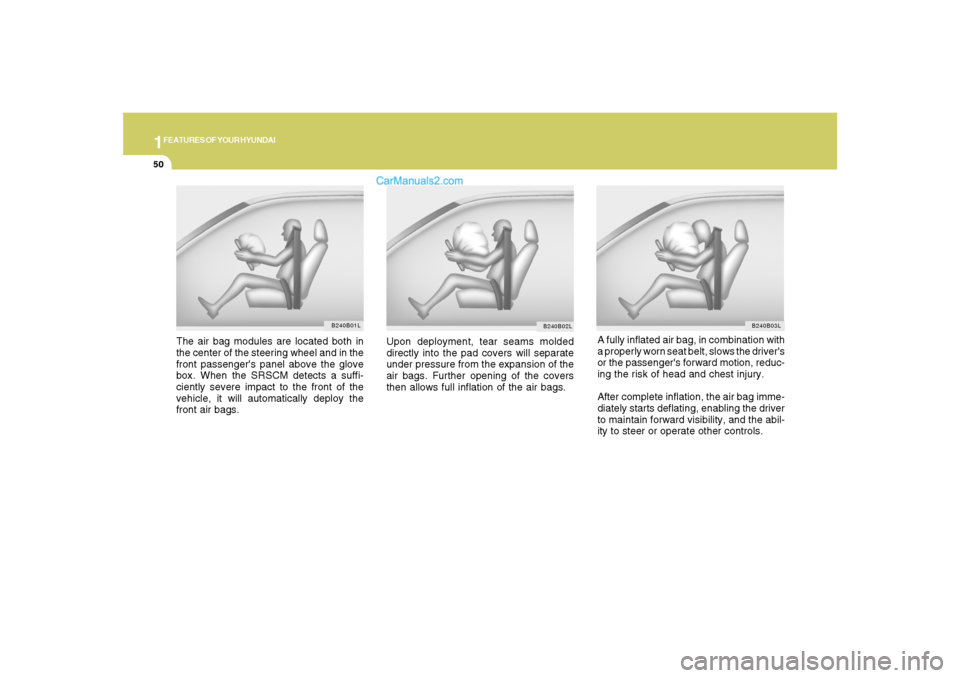
1FEATURES OF YOUR HYUNDAI50
A fully inflated air bag, in combination with
a properly worn seat belt, slows the driver's
or the passenger's forward motion, reduc-
ing the risk of head and chest injury.
After complete inflation, the air bag imme-
diately starts deflating, enabling the driver
to maintain forward visibility, and the abil-
ity to steer or operate other controls.
B240B03L
Upon deployment, tear seams molded
directly into the pad covers will separate
under pressure from the expansion of the
air bags. Further opening of the covers
then allows full inflation of the air bags.
B240B02L
The air bag modules are located both in
the center of the steering wheel and in the
front passenger's panel above the glove
box. When the SRSCM detects a suffi-
ciently severe impact to the front of the
vehicle, it will automatically deploy the
front air bags.
B240B01L